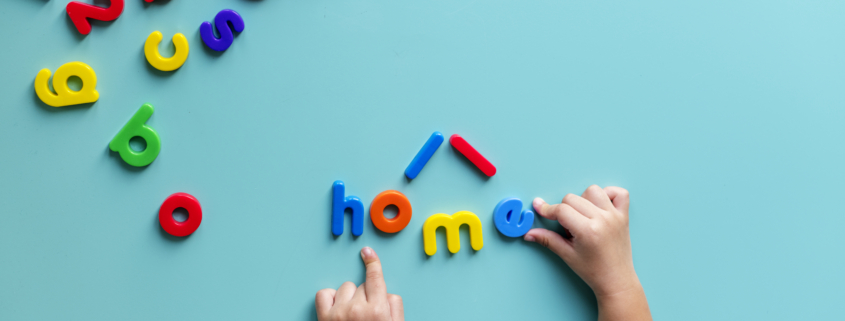In the fascinating expedition of childhood development, few landmarks are as pivotal as the recognition of alphabet letters. This cornerstone skill serves as a bridge to the realms of reading and writing, while also wielding profound influence over cognitive advancement.
As parents and caregivers this vital milestone can be frustrating and confusing. In this article, we answer the question, “When should a child recognize letters of the alphabet?” and all of your related questions.
Milestones in Alphabet Recognition
Here are some key milestones to look out for on the journey to alphabet recognition.
1. Early Signs of Interest
Before the formal journey of recognizing letters commences, there are often subtle signals that a child is ready to explore the world of the alphabet. Children might exhibit curiosity by pointing to letters in everyday life — on cereal boxes, street signs, or books.
2. Letter Singing and Rhyming
The transition from mere sounds to their visual representations begins with nursery rhymes and rhythmic songs. Children start associating the sounds they joyfully chant with the letters they see. This connection becomes a vital foundation for letter recognition.
3. Letter Imitation
As children progress, their scribbles on paper may not resemble perfectly formed letters, but they signify a major cognitive leap. These early experiments reflect a child’s attempt to replicate the shapes they see in their surroundings.
4. Letter Naming
Children will begin identifying and naming letters in diverse contexts. This stage showcases their capacity to recognize letters not only within their immediate environment but also in unfamiliar settings.
5. Letter Sound Association
A cornerstone milestone, associating letter shapes with their corresponding sounds lays the groundwork for understanding the intricate process of reading. The ability to decode and comprehend words hinges on this fundamental connection as children bridge the gap between visual symbols and auditory cues.
When Should a Child Recognize Letters Of The Alphabet?
The answer is between the ages of three and four. Most children of a standard cognitive ability will recognize letters of the alphabet before the start of Kindergarten.
Factors Influencing Alphabet Recognition
Some children recognize letters before the age of three, and some have trouble mastering this skill in Kindergarten. There are many factors that can impact alphabet recognition. While milestones vary from child to child, children typically start alphabet recognition between the ages of two to four, but the range can vary widely.
Here are some factors at play.
Language Environment
The linguistic environment a child is immersed in plays a paramount role. A language-rich ambiance, saturated with conversations, stories, and exposure to a plethora of words, offers an accelerant for alphabet recognition.
Parental Involvement
Parents are powerful catalysts in nurturing early literacy. Active participation through engaging conversations, shared reading experiences, and creating opportunities for learning can have a profound impact on a child’s progress.
Exposure to Literature
The magic of literature can never be overstated. Reading aloud to children, sharing the enchantment of books, and weaving tales together not only enhances alphabet recognition but also crafts a lifelong affection for reading.
The Role of Exposure to Literature
The tradition of reading aloud from infancy is a symphony of sights, sounds, and emotions. Beyond nurturing language skills, it imparts the rhythm and cadence of speech, opening doors to the melodious world of language. Engaging children in conversations while reading enhances their comprehension and critical thinking skills.
Questions like “What do you think will happen next?” stimulate cognitive engagement and reinforce letter recognition.
Diversifying reading materials beyond traditional books widens a child’s horizon. Incorporating magazines, newspapers, and even digital content exposes them to words and letter arrangements, enriching their letter recognition journey.
Options for Parents Whose Children Are Falling Behind
Children embark on developmental journeys uniquely their own. Patient observation allows parents to acknowledge incremental progress, celebrating each step in the letter recognition process. It’s also important to understand that progress isn’t always linear.
Celebrating small victories and recognizing that each step, no matter how small, signifies forward movement can boost confidence. Here are some other important options for parents.
- Personalized Learning: Customizing approaches based on a child’s interests and learning style fosters engagement. Tailoring activities to resonate with their preferences ensures that learning remains a joyful exploration.
- Professional Guidance: For persistent concerns, seeking advice from educators or child development specialists can offer valuable insights. Their expertise can help identify potential roadblocks and design strategies to overcome them.
Premier Child Learning at Cadence Education
Alphabet recognition is the stepping stone to a lifelong journey of learning and discovery. At Cadence Education, we understand the significance of these early developmental milestones. Our expert educators are dedicated to creating nurturing environments that foster not only alphabet recognition but also a love for learning.
Contact us today to embark on this enriching educational adventure with Cadence Education.

